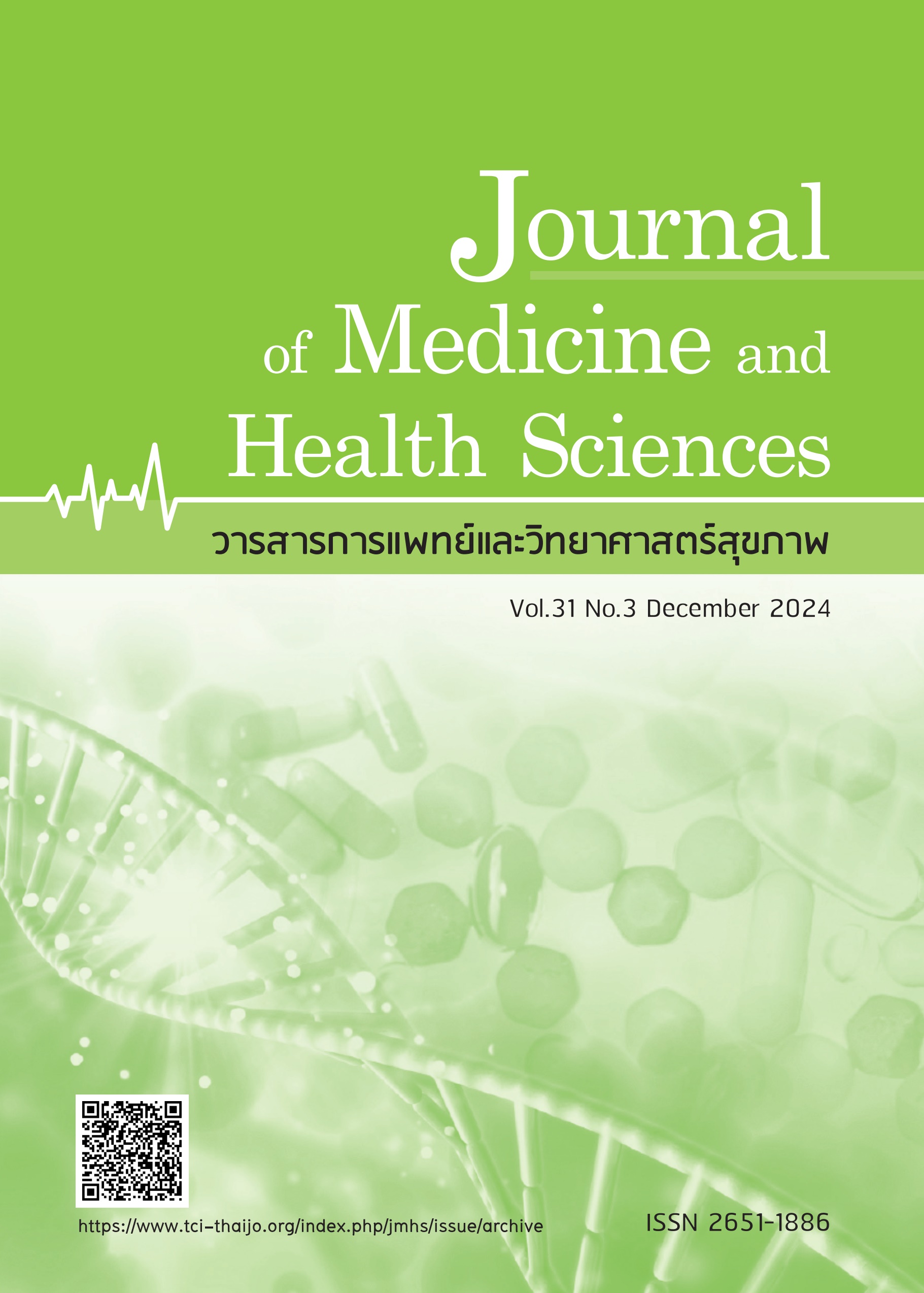The association of mild thrombocytopenia that impact on increasing risk of postpartum hemorrhage
Keywords:
mild thrombocytopenia, postpartum hemorrhage, nulliparous, term, singletonAbstract
Postpartum hemorrhage (PPH) is one of the three most common obstetric conditions leading to maternal mortality. Moreover, thrombocytopenia is a known risk factor for PPH, but the platelet count levels considered to be significant risk factors vary across institutions. Mild thrombocytopenia, defined as a platelet count between 100,000 and 149,999 cells/microliter, remains controversial as a potential risk factor for PPH. This study aimed to investigate the relationship between mild thrombocytopenia and the increased risk of postpartum hemorrhage. A retrospective cohort study was conducted among pregnant women of all ages who delivered at Trang Hospital between October 2019 and July 2024. The study included singleton pregnancies between 37 and 41 weeks and 6 days, with nulliparous women as participants. Participants were divided into two groups, comprising 1,200 women with normal platelet counts (≥150,000 cells/microliter) and 120 women with mild thrombocytopenia were included. The results showed that women with mild thrombocytopenia had a 2.195-fold higher likelihood (95% CI 1.094-4.406, p=0.025) of experiencing PPH compared to those with normal platelet counts. Furthermore, the mild thrombocytopenia group was 2.400 times more likely (95% CI 1.004-5.734, p=0.044) to have an estimated blood loss of 1,000 milliliters or more within 24 hours after childbirth. In conclusion, mild thrombocytopenia increases the risk of postpartum hemorrhage and the likelihood of blood loss ≥1,000 milliliters within 24 hours after delivery compared to women with normal platelet counts.
References
Say L, Chou D, Gemmill A, et al. Global causes of maternal death: A WHO systematic analysis. Lancet Glob Health 2014;2:323-33. doi:10.1016/S2214-109X(14)70227-X.
Yee LM, McGee P, Bailit JL, et al. Daytime compared with nighttime differences in management and outcomes of postpartum hemorrhage. Obstet Gynecol 2019;133:155-62. doi:10.1097/AOG.0000000000003033.
Berg CJ, MacKay AP, Qin C, et al. Overview of maternal morbidity during hospitalization for labor and delivery in the United States: 1993-1997 and 2001-2005. Obstet Gynecol 2009;113:1075-81. doi:10.1097/AOG.0b013e3181a09fc0.
American College of Obstetricians and Gynecologists. ACOG practice bulletin: Clinical management guidelines for obstetrician-gynecologists Number 76, October 2006: Postpartum hemorrhage. Obstet Gynecol 2006;108:1039-47. doi:10.1097/00006250-200610000-00046.
Committee on practice bulletinsobstetrics. Practice bulletin No. 183: Postpartum hemorrhage. Obstet Gynecol 2017;130:e168-86. doi:10.1097/AOG.0000000000002351.
Srisupundit K. Postpartum hemorrhage. [cited 2024 Aug 27]. Available from: https://w1.med.cmu.ac.th/obgyn/lessons/33365/.
Tao L, Vikas B, Connie Q, et al. First aid for the USMLE step 1. United States of America: McGraw Hill; 2024. p.417.
American College of Obstetrics and Gynecologists [Internet]. District II safe motherhood initiative: Maternal safety bundle for obstetric hemorrhage. Obstet Gynecol; 2020. [cited 2024 Aug 27]. Available from: https://www.acog.org/-/media/project/acog/acogorg/files/forms/districts/smi-ob-hemorrhage-bundleslides.pdf.
Lyndon A, Lagrew D, Shields L, et al. Improving health care response to obstetric hemorrhage, a California Maternal Quality Care Collaborative Toolkit to Transform Maternity Care. Stanford, CA: California maternal quality care collaborative [Internet] 2015 [cited 2024 Aug 27]. Available from: https://www.cmqcc.org/sites/default/files/HEMToolkit_03252022%20Errata%207.2022%20%282%29.pdf.
Reese JA, Peck JD, Deschamps DR, et al. Platelet counts during pregnancy. N Engl J Med 2018;379:32-43. doi:10.1056/NEJMoa1802897.
Boehlen F, Hohlfeld P, Extermann P, et al. Maternal antiplatelet antibodies in predicting risk of neonatal thrombocytopenia. Obstet Gynecol 1999;93:169-73. doi:10.1016/s0029-7844(98)00390-1.
Boehlen F, Hohlfeld P, Extermann P, et al. Platelet count at term pregnancy: A reappraisal of the threshold. Obstet Gynecol 2000;95:29-33. doi:10.1016/s0029-7844(99)00537-2.
Dilla AJ, Waters JH, Yazer MH. Clinical validation of risk stratification criteria for peripartum hemorrhage. Obstet Gynecol 2013;122:120-6. doi:10.1097/AOG.0b013e3182941c78.
Kramer MS, Berg C, Abenhaim H, et al. Incidence, risk factors, and temporal trends in severe postpartum hemorrhage. Am J Obstet Gynecol 2013;209:449.e1-7. doi:10.1016/j.ajog.2013.07.007.
Govindappagari S, Moyle K, Burwick RM. Mild thrombocytopenia and postpartum hemorrhage in nulliparous women with term, singleton, vertex deliveries. Obstet Gynecol 2020;135:1338-44. doi:10.1097/AOG.0000000000003861.
Ngamjarus C, Pattanittum P. n4Studies: Application for sample size calculation in health science research. Version 2.3. App store; 2024.
Menard MK, Main EK, Currigan SM. Executive summary of the revitalize initiative: Standardizing obstetric data definitions. Obstet Gynecol 2014;124:150-3. doi:10.1097/AOG.0000000000000322.
Rottenstreich M, Rotem R, Glick I, et al. Mild gestational thrombocytopenia in primiparous women, does it affect risk of early postpartum hemorrhage? A retrospective cohort study. J Matern Fetal Neonatal Med 2022;35:8426-33. doi:10.1080/14767058.2021.1977793.
Balduini CL, Bertolino G, Noris P, et al. Defect of platelet aggregation and adhesion induced by autoantibodies against platelet glycoprotein IIIa. Thromb Haemost 1992;68:208-13.
Onisâi M, Vlădăreanu AM, Spînu A, et al. Idiopathic thrombocytopenic purpura (ITP) - new era for an old disease. Rom J Intern Med 2019;57:273-83. doi:10.2478/rjim-2019-0014.
DiSciullo A, Mokhtari N, Landy H, et al. Effect of mild preoperative thrombocytopenia on postpartum hemorrhage after cesarean deliveries. Am J Obstet Gynecol MFM 2021;3:100368. doi:10.1016/j.ajogmf.2021.100368.
Ciobanu AM, Colibaba S, Cimpoca B, et al. Thrombocytopenia in pregnancy. Maedica (Bucur) 2016;1:55-60.
Sibai BM. Diagnosis and management of gestational hypertension and preeclampsia. Obstet Gynecol 2003;102:181-92. doi:10.1016/s0029-7844(03)00475-7.
Downloads
Published
How to Cite
Issue
Section
License
Copyright (c) 2024 Journal of Medicine and Health Sciences

This work is licensed under a Creative Commons Attribution-NonCommercial-NoDerivatives 4.0 International License.





